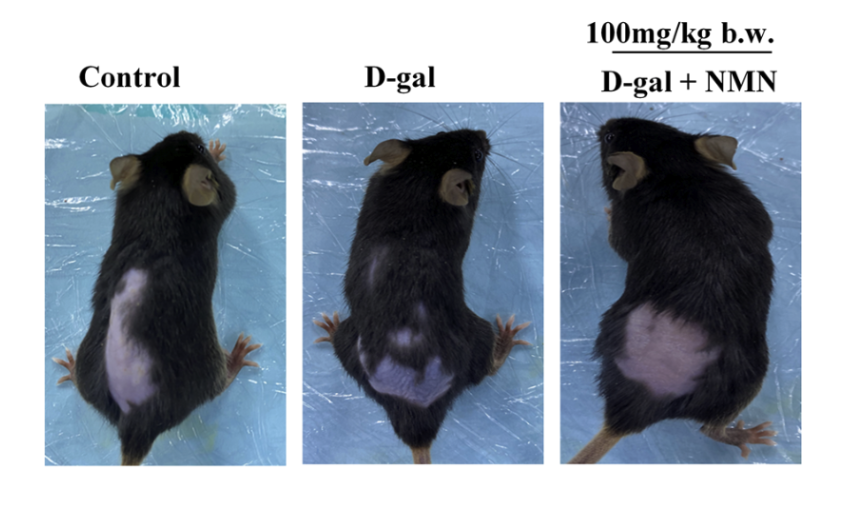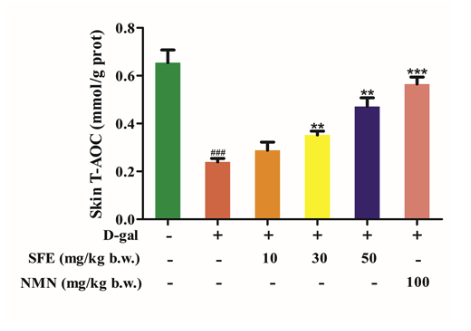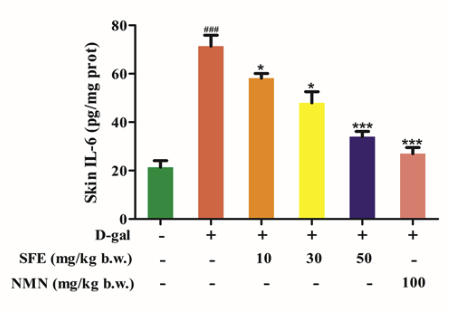The potential benefits of NMN for skin aging were demonstrated in a study where it served as a positive control – a benchmark – to measure the effectiveness of sulforaphane, another potential anti–aging compound.
Key Points
This study highlighted multiple benefits of NMN for the skin:
- Reduced visible signs of aging
- Increased collagen production for improved skin structure
- Enhanced antioxidant defense against free radicals
- Decreased markers of inflammation
NMN Used as Reference for Effective Protection Against Skin Aging
Researchers used D-galactose (D-gal) injections to mimic skin aging in mice. Mice were divided into six groups and received the following treatments over 8 weeks:
- Control group: Saline (no aging or treatment)
- D-gal group: Aging induced with D-gal (no treatment)
- NMN group: D-gal + NMN (100 mg/kg b.w.)
- Low-dose SFE (L-SFE): D-gal + SFE (10 mg/kg b.w.)
- Medium-dose SFE (M-SFE): D-gal + SFE (30 mg/kg b.w.)
- High-dose SFE (H-SFE): D-gal + SFE (50 mg/kg b.w.)
The experiment lasted for 8 weeks, during which skin samples were analyzed to evaluate the effects of NMN and sulforaphane.
NMN Improved Skin Appearance and Integrity
NMN treatment reduced visible signs of skin aging in mice, including dryness, thinning, and loss of elasticity.
As shown in the figure below, healthy mice (control) exhibited normal skin appearance. In contrast, prematurely aged mice (D-gal) displayed signs of aging, such as dryness and thinning. Notably, NMN treatment in prematurely aged mice (D-gal + NMN) significantly improved skin condition, mitigating these age-related changes.

Skin analysis showed NMN increased collagen levels and improved collagen organization, helping restore the skin’s structural integrity.
NMN also increased levels of key molecules essential for healthy skin:
- Hyaluronic acid (HA): A molecule that keeps skin hydrated and plump
- Hydroxyproline (HYP): A building block of collagen
Additionally, NMN enhanced the expression of genes involved in collagen production, supporting collagen synthesis and promoting healthier, more resilient skin.
Increased Antioxidant Protection Against Free Radical Damage
NMN boosted the activity of antioxidant enzymes (CAT and SOD) and reduced markers of oxidative damage (MDA and 4-HNE).
Skin T-AOC (Total Antioxidant Capacity), a measure of the overall ability to neutralize dangerous free radicals, was increased by treatment with NMN.

This figure shows T-AOC levels were significantly lower in mice with aged skin (red bar) compared to healthy mice (green bar). NMN (pink bar) significantly protected against this reduction. High-dose sulforaphane (purple bar) also increased levels, while medium-dose (yellow bar) showed moderate protection, and low-dose (orange bar) had no effect.
Reduced Inflammatory Compounds in Skin
NMN significantly lowered pro-inflammatory markers (TNF-α, IL-1β, IL-6, MMP-3, and MMP-1), which were elevated in untreated aged mice.
This figure shows that IL-6 levels were significantly higher in mice with aged skin (red bar) compared to healthy mice (green bar). NMN treatment (pink bar) maintained IL-6 levels closer to those of healthy mice. Sulforaphane lowered IL-6 in a dose-dependent manner, with the most significant reduction seen at high doses (purple bar).

At the same time, NMN increased levels of the anti-inflammatory factors TGF-β and IL-10, highlighting its potential to restore inflammatory balance in the skin.
Conclusion
NMN treatment effectively revitalized aging skin in mice, enhancing both its visible appearance and underlying molecular structure.
Signs of aging, including dryness, loss of elasticity, and thinning, were notably reduced.
Collagen levels increased and became more organized, strengthening the skin’s structural integrity.
Antioxidant levels were enhanced, while markers of oxidative damage decreased, improving the skin’s total antioxidant capacity.
Inflammatory compounds were significantly reduced, and levels of anti-inflammatory molecules increased, promoting a healthier skin environment.
